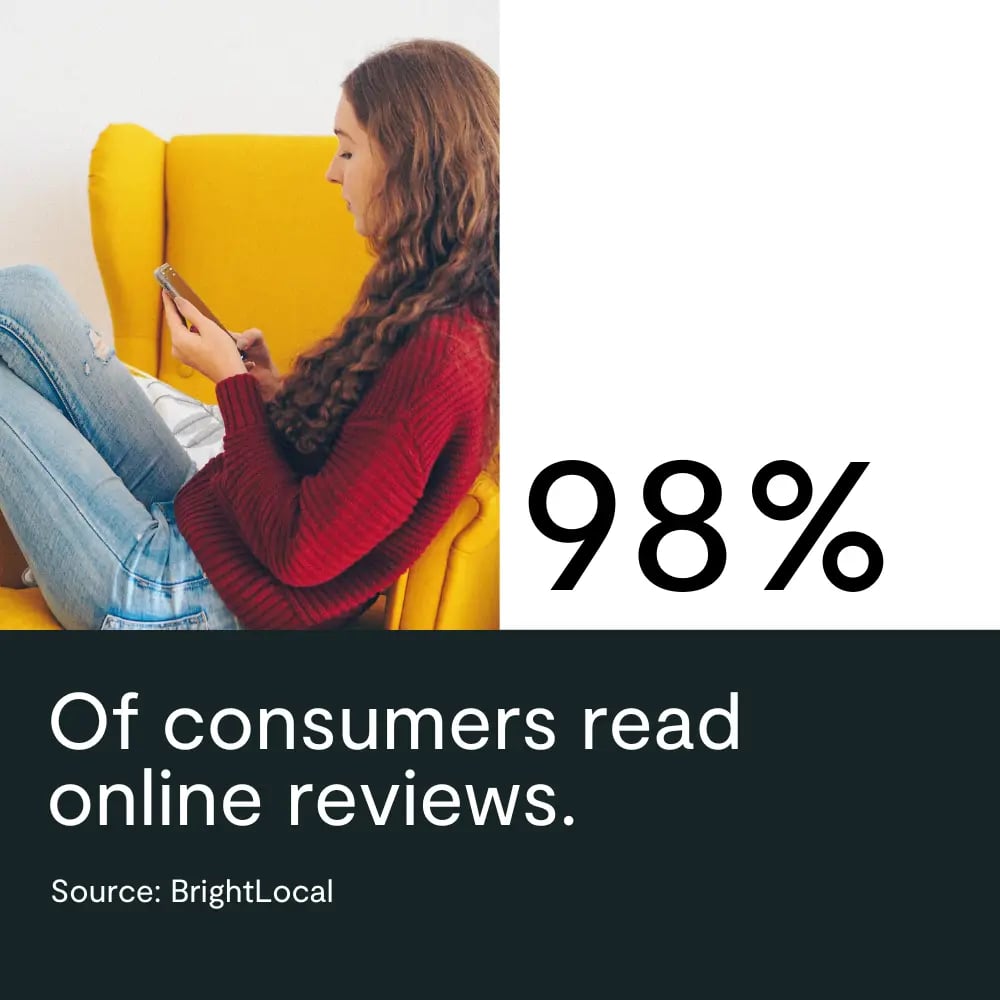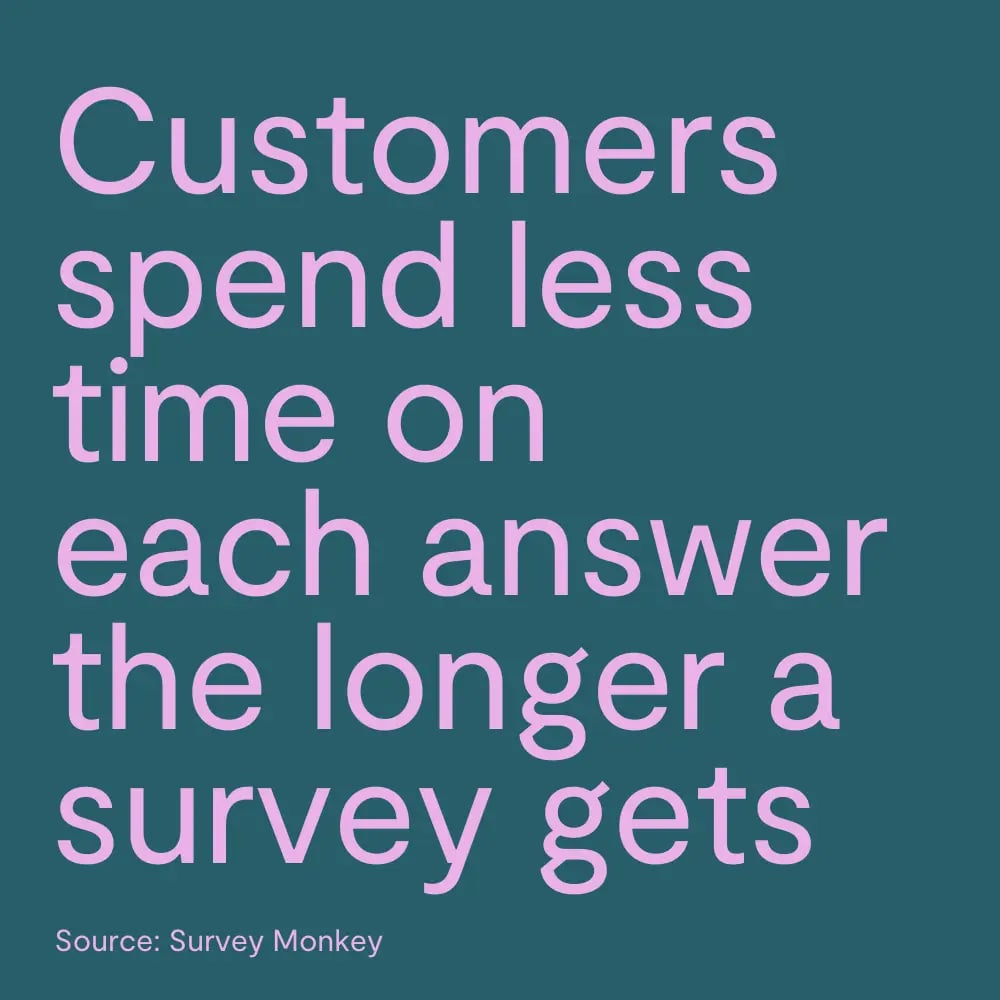Customer feedback helps you learn about your audience, market, and product or service. Collecting these powerful insights can guide your brand on your endless quest to grow and scale.
If you have ever wondered why collecting customer feedback is important, how to collect it, or how to use the feedback to improve every part of your business, look no further. You'll get an answer to these and more questions in this article.
Benefits of collecting customer feedback
Collecting customer feedback should be a priority for any business. Customers are your direct line to valuable insight into what your customers think about your business — for better or worse.
The learnings you get by collecting feedback can help your business to enhance customer satisfaction, drive business growth, foster innovation, and build brand loyalty and trust. Let's dive deeper in the following section.
Enhancing customer satisfaction
Customer satisfaction should be at the top of your agenda. It's intimately correlated with vital concepts like customer retention and loyalty.
But customer satisfaction it's not just about holding on to customers. Research published in the Harvard Business Review shows that customers who have great experiences with brands spend about 140% more. Get things right, and you can boost your revenues.

A strong customer feedback strategy will help you boost satisfaction. There are two main dimensions to consider here that underline.
Understanding customer needs and expectations
Feedback can help you understand what your customers want and need from your product. Listening to your customers is an excellent way to see your brand through their eyes. It can help deepen your understanding of their pain points and how they use the product.
Products and services should always be developed with the customer at the center. However, as implementation occurs, it's easy to drift from that idea.
Feedback helps re-focus on delivering value for the customer and providing them with the service they need.
Identifying areas of improvement
Customer feedback helps you understand what you need to improve in your product or service. Survey respondents can enlighten you in unexpected ways and even be a source of excellent ideas. You need to give weight to feature requests or points of frustration that keep coming up.
Not all the new ideas will be realistic to implement. However, you can find the information you need to take your product or service from very good to great. What's more, listening to your customers and making the changes they want is a big step toward satisfaction and customer loyalty.
Driving business growth
Growth is on the minds of all entrepreneurs, regardless of industry or business model. Customer acquisition costs are rising, so finding organic marketing opportunities and retaining existing customers has never been more important.
The power of reviews
According to BrightLocal's recent local consumer review survey, 98% of consumers read online reviews, with almost the same number trusting them as much as personal recommendations. When paired with customer testimonials, this type of feedback can act as a powerful organic acquisition channel.

Moreover, brands that collect feedback and take action can resolve problems and reduce customer churn. This process boosts loyalty, trust, and satisfaction and increases retention rates.
Better understanding = better solutions
Customer feedback allows you to understand the needs of your existing and target audience. More profound knowledge of your users and their pain points helps you make better decisions.
For example, suppose customers frequently mention a product or service they'd like to see added to your offering. In that case, it's pretty clear that the company should at least explore that possibility in future iterations of the offering.
Fostering innovation
In the world of startups and entrepreneurship, founders with grand visions are celebrated and cherished. The best products or services seem to spring out of nowhere and fill a gap in the market that most people didn't know even existed. But when people talk about brave founders forging a new path, no one talks about all the products that failed to make the grade.
Innovation can be achieved in several different ways. It's not just about blue-sky thinking. Brands that gather customer feedback keep their finger on the pulse and have a closer relationship with their users.
Instead of guessing or telling them what they want, they can work alongside customers to deliver the necessary products or services.
Customer feedback surveys are a gold mine of great ideas. If you start with a core product, your customers will often be able to suggest related offerings that you didn't know were important to have.
A customer feedback loop is a huge part of a solid customer experience (CX) strategy. With each new iteration of a product or service, you can have access to the people who will ultimately judge if your offer is worth paying for. Forging these close bonds will help you keep your finger on the pulse.
Your customers are everything. Sometimes brands forget this as they scramble to add new features, functions, or extra dimensions to their solution. Above all else, customers want products or services that solve their problems. You can't know what those issues are unless you listen.
Building brand loyalty and trust
Every brand wants trusting and loyal customers. They stick around, spend more, and advocate for your solution to friends and families. However, establishing these bonds take time, effort, and commitment.
One of the best things you can do is ensure your users feel seen and heard. Gathering and analyzing customer feedback is an essential part of this process.
Negative feedback and other customer issues should be seen as a learning opportunity. When your customers know you are listening and ready to integrate their opinions, it strengthens your relationship.
Get customer-centric
Customer-centric brands focus on delivering value to their users. They aim to adapt and adjust to consumers' evolving wants and needs. This process leads to long-lasting and meaningful relationships.
Opening up clear lines of dialogue between you and your users, and using this data to power decisions, has so many benefits for brands, retailers, and service companies alike. It can help reduce customer acquisition costs (CAC) because being better able to retain your existing customer base.
What's more, returning customers who feel valued and listened to can drive up revenues through repeat business and high customer lifetime value (CLV).
Tips for gathering customer feedback
OK, so we've established why you need to collect customer feedback to grow your business and establish valuable long-term relationships. But how do you get that important data that you can use to bring your solution to the next level? You can start by following these tips.
Choose the right methods
There are lots of different methods that you can use to collect customer feedback. Each of them has advantages that make them suitable for gathering specific types of information. Choosing the right methods depends on the goals and objectives of your feedback and the type of data and customers you target.
Surveys
A customer feedback survey is a powerful method for gathering crucial information. Both long and short-form surveys have their place,
Online and email surveys
Online and email surveys offer brands a way to capture in-depth information. However, it's a bit of a balancing act. While you'll no doubt be eager to gather as much data as possible, you risk alienating your survey respondents if there are too many questions.
Another thing to remember is that the more questions you add, the more likely it is that your customer will speed through the answers. As shown by this Survey Monkey research, customers spend less time on each answer the longer a survey gets.

Online form-based surveys are ideal for when you want to include open-ended questions.
Email surveys are cost-effective and efficient ways to gather customer feedback. They have decent response rates and are particularly useful because they scale well.
In-app or in-store surveys
One of the biggest problems brands face when gathering customer feedback is getting a response. In fact, some research suggests that mobile web surveys have response rates of 1% to 3%.
You've probably come across pop-up windows on digital services that ask for your satisfaction, for example, with emojis. The main advantage of these simple in-app surveys is the staggering response rate. In fact, in-app surveys get an average response rate of 13%. For companies with smaller customer bases, this difference is highly significant.
But how do you achieve the same benefits in a physical environment or if your business doesn't have an app? HappyOrNot is a pioneer in customer feedback and offers a wide range of solutions for measuring customer satisfaction in the in-store environment. So, if you haven't yet found a scalable way to solicit feedback from your walk-in customers, here's one option.
One explanation for the high response rates with in-app or in-store surveys is that they are shorter in nature. Sometimes, these surveys might comprise only a handful of questions, or in the case of the net promoter score (NPS), just one — "On a scale of 0 to 10, how likely are you to recommend our business to a friend or colleague?"
Other popular short-form surveys include the customer satisfaction score (CSAT). Like NPS, these surveys are deceptively simple and can help you get a great sense of customer sentiment. However, they won't always provide qualitative information.
It's important to remember that your customer is not in your app or store to answer the survey. They have other business to attend to, which they defer to help you out. As such, keep these surveys as light and short as possible.
You have a few options when you want to dig deeper and get at the root causes. For example, you can target respondents with a follow-up interview using some of the other methods on our list.
Exit-intent survey
Exit-intent surveys are an excellent tool for understanding the reasons behind customer churn, which is particularly relevant for subscription-based business models. If a subscriber is canceling their service, it's essential to give them an opportunity to air the reasons.
Sometimes the cause will be out of your control. Other times it will provide insights that you can use to prevent other users from leaving. So ensure you build these functions into your website.
Interviews and focus groups
Interviews and focus groups are a time-honored way to collect customer feedback. However, unlike the other options on our list, they take a lot of organization. They can also be expensive. However, you can use video communication tools like Teams and Zoom to overcome some of these issues.
Overall, they're a great choice when you need high-quality, granular qualitative feedback.
One-on-one interviews
One-on-one interviews can be an excellent way to collect in-depth and nuanced feedback. The nature of these exchanges allows for extended conversation, follow-up questions, and a greater degree of clarity.
Selecting the right people for one-on-one interviews is something of an art. For starters, you must find the right blend of individuals representing your customer base comprehensively.
Use this format when you must dig in and explore issues in a way that quantitative feedback can't accommodate. However, be aware that asking questions face-to-face can skew results.
For example, if you ask for feedback on a new product or service feature, some people will mask their true feelings with kindness. Often, this happens on a subconscious level. So find ways to get at the truth by phrasing your questions.
Group discussions
Group discussions and focus groups are a great way to get the opinions of a cross-section of your customers or society. The face-to-face nature of these events allows you to collect customer feedback from several perspectives.
Hosting group discussions requires a bit of experience. These conversations can easily spiral out of control if the group gets stuck discussing things unrelated to delivering a better customer experience. However, an assured figure with a solid schedule should keep things on track.
Social media and online reviews
Internet users are never short of an opinion. But that's a good thing when you need to gather customer feedback. In ways, this is some of the purest feedback you can find. However, it's important to remember that unhappy customers are far more likely to write reviews than satisfied users. Some estimates suggest they're two or three times more likely.

Monitoring social media channels
Your social media comments are an excellent source of customer sentiment. While we all love positive feedback, negative comments are just as important.
Look out for comments below your post and shares. Similarly, your mentions can give you some valuable feedback. But don't stop there. Social listening software can help you gather feedback from customers not actively interacting with your brand.
Analyzing online reviews on platforms like Yelp or Google Reviews
Third-party review sites like Yelp and Google can be a great well to know how your customers feel. Again, keep an eye out for unhappy customers and see if your support team can intervene. If you get actionable feedback, try to use it to improve your product.
Designing effective feedback collection tools
Collecting customer feedback is essential, so you must streamline the process to make it as quick and painless as possible. The best way to do that is by designing practical feedback collection tools.
There are a range of tools out there that can help, from online survey platforms to in-app widgets. Here are some best practices to follow when building consumer feedback models.
Craft clear and concise questions
You must establish clear goals and objectives before you start collecting customer feedback. When you know what information you need, it will guide the questions that you must ask. But beyond that, you also need to be very deliberate in how you phrase your questions.
At all times, strive for clear, punchy questions. Any misunderstandings can skew your data. In short, know what you need to know what data you need and plot the shortest path toward getting it.
Use a mix of open-ended and closed-ended questions
Closed-ended questions are a great way to get customer feedback that you can aggregate into powerful insights. However, while a bit messier to pull together, open-ended questions will give you access to unexpected but valuable thoughts and opinions. In short, both qualitative and quantitative questions have their place.
Ensuring anonymity and confidentiality
Before you request feedback, you need to ensure both confidentiality and anonymity. For starters, you must protect any data that your customers provide. Secondly, if you want real honesty, you must ensure that all customers can talk freely.
Encouraging customer feedback
Gathering feedback is so essential that you can't leave it up to chance. You need to find ways to increase your response rates so you can leverage the benefits.
Offer incentives and rewards
It's pretty standard practice to offer rewards, especially for longer surveys. You can approach incentivizing your customer feedback surveys in a few different ways.
For starters, you can offer a cash equivalent prize, discounts, or special offers. Alternatively, you could offer a place in a draw for a big prize.
As always, think about your customers and what they want. Try and get rewards or offers that align with their interests and your brand.
Making the feedback process easy and accessible
A survey with too much friction is one of the biggest things that will hurt your response and completion rate. Make it available across different platforms, easy and fun to complete, and always communicate the number of questions and the average completion time.
Always say thanks
Little kindnesses like this can go a long way. Always say thanks after collecting customer feedback. When customers share their opinions, they're giving you something valuable. Ensure they know that you appreciate their efforts.
Implementing a customer feedback loop
A customer feedback loop is a set of repeating steps that allow you continuously enhance the customer experience. You can collect, synthesize, and action feedback by formalizing the process and creating optimal workflows.
Some of the benefits of a customer feedback loop are better products and greater customer loyalty and satisfaction. Here are the steps you need to build one.
1. Asking for feedback
The loop needs to start somewhere. And that place is collecting feedback. In the tips for gathering customer feedback, we have outlined the different ways to source customer opinions and the best practices for collecting this important data.
Again, it's about establishing the goals and objectives of your feedback. You don't need to limit yourself to one goal. But you must break down each potential benefit and find the best methods to unlock that information.
For example, if your goal is to improve customer service, you can include a mix of in-app CSAT scores that appear after customer interactions with support staff. On top of that, you could reach out to users who have raised support tickets and engage them with more extensive customer surveys.
Customer responses are the basic raw materials of your loop. Make the process as seamless as possible so you always have fuel for your feedback fire. So make your feedback requests and wait for the data to roll in.
2. Categorize the feedback
If you've used multiple channels to collect feedback, it will be scattered across different places. So, the first step is to centralize the data in one point.
Most customer feedback tools have dashboards with a high-level overview of the data. But if you want to bring all your data under one roof, you'll need to export the various results and reports and merge them into one spreadsheet.
Now, you're ready to categorize the data. Once more, this area will be much easier if you've established clear goals. Some of the categories and sub-categories you can divide your data into are things like:
-
Customer service
-
Customer Success
-
Product or feature feedback
-
User onboarding
The main point of this process is to make the data easy to read and interpret. Customer feedback will involve and affect every department within your business. Team leaders must be able to access the data and understand and interpret it seamlessly.
Another thing to consider here is splitting up your customer responses. Two obvious categories you'll want are positive and negative feedback. However, it's also good to include a category for neutral replies.
While you might not think that neutral feedback is as valuable as good or bad feedback, these customers represent a segment that you have the potential to turn into loyal customers by addressing their concerns
Once your data is structured and categorized, it's time for the exciting part: analyzing and finding patterns.
3. Analyze and interpret customer feedback
There are two main methods for analyzing and interpreting customer feedback. You can do it manually, or you can use data analytics tools.
Using analytics tools
One of the main areas where AI has thrived in recent years is the data analytics space. As such, there is no shortage of business intelligence tools to help you interpret your data and transform it into actionable insights.
Many of these tools will be overkill for smaller businesses with limited customer feedback data. But if you're working with larger data sets, AI and ML tools can help you find unexpected patterns with incredible efficiency.
Some of the functions that are handy when you have a lot of qualitative data are things like:
Keyword analysis
You can use keyword analysis to build word maps and other visualizations to give you a sense of how your consumers feel and what subjects are important to them.
Sentiment analysis
This process can save you time categorizing feedback as positive, negative, or neutral. These tools allow you to monitor your customers' feelings about your brand and identify successes and failures.
Topic analysis
Topic analysis tools are more sophisticated. These AI tools can read and "understand" customer responses and help you accurately categorize them.
Manual analysis
Manual data analysis is a good option for smaller teams. Essentially, it involves pouring through the data and finding and recording patterns. Look for sentiment and repeating keywords and topics. Find ways to tag each theme and observe the root of any problem.
Soon, you should be able to see what drives your customers to develop bonds with your company or churn.
4. Communicating changes to customers
Once you've identified the issues hurting customer happiness, it's time to make changes. Prioritize the most significant issues and let your users know about the updates.
Where possible, it's a great idea to follow up with customers who have expressed their concerns about some aspect of your product or service. A personalized email outlining your changes can make a significant impact.
If customers have left negative reviews, you can inform them about the updates and ask them to reconsider their score. This process is delicate, so don't rush in blind. Use your best judgment and ensure you've resolved all their issues.
Another good idea is to look through your positive feedback and ask if your customers mind if you use it for testimonials. This social proof is a compelling way to improve customer acquisition.
Use feedback to drive improvements
The main reason to collect customer feedback in the first place is so that you can make significant improvements to your business.
These improvements can be across any area of your company, from the quality of your products to customer service, pricing, billing, marketing, and more.
Let's explore the main areas you can boost when collecting customer feedback.
Get product improvement ideas
Collecting and acting on customer feedback alters the relationship between your brand and your customers. With the right approach, the development of your solutions becomes far more collaborative.
As mentioned above, the customer feedback loop creates constant motion and allows you to integrate your customer's needs and wants within your business development.
When brands listen, they can make the most of valuable customer feedback. Your product or service should solve a pain point for your users. So canvassing for their opinions will give you an excellent feel for whether you are achieving that goal.
So study your customer interviews and surveys for new ideas, offerings, functions, or more. Ensure your team has a line to the data to explore the feasibility of upgrading your value proposition to give your users what they want.
Optimize your user journeys
Collecting feedback can help you streamline and optimize the customer journey. Asking questions about your website, onboarding, and payment processes, can help highlight points of friction and help you improve your overall offering.
It's important to note that good onboarding experiences are strong predictors of user retention. You need your users to understand the benefits of your solution as soon as possible. So ensure they have all the information they need to extract value as efficiently as possible.
What's more, with the proper customer survey methods, you can learn more about your website's role in sales and conversions. This process goes beyond but complements other web optimization activities like A/B testing copy and images.
For example, it can be the difference between understanding that something doesn't work and understanding why it's not getting the results you're expecting.
Discover your biggest fans
When you collect customer feedback, it's natural that negative comments and results will get the lion's share of your attention. Anything that is harming customer experience should be addressed as quickly as possible. However, you can learn just as much from your happy customers.
The idea here is that you can identify your biggest fans. Engaging with customers who love your solution is a great way to boost customer satisfaction and loyalty. These users have the potential to turn into brand advocates who can inspire potential customers to use your product or service.
Improve your marketing efforts
One of the biggest benefits of a solid customer feedback strategy is its ability to improve your marketing. Any process that brings you closer to your customers will help you understand what your target audience wants and what messaging will resonate with them.
Gathering feedback will help you understand how your audience feels about their pain points and how they talk about them. On a simpler level, a "How did you find us?" question can tell you a lot about which marketing channels are generating results.
Mine your repeat customers' data and use these learnings to ensure your marketing budget is allocated toward the channels that make the biggest difference.
Reduce churn
Reducing customer churn is a massive part of growing and scaling revenue. Acquiring customers is expensive, so you must go the extra mile to hold onto everyone you can. Naturally, collecting and acting on customer feedback is a great way to improve the customer experience for your existing and future users.
Responding to customer feedback ensures your clients know they are valued and important. While that's a task that your customer support team can complete, if you want to reduce customer attrition, you need to get proactive. Take the time to understand the factors that cause customers to leave and make the improvements and changes that will better resonate with them.
Conclusion
Building a customer feedback strategy is essential. Your customer base is an incredible source of information about the value your business generates. To take customer satisfaction to the next level, you must leverage this data.
Get as many business functions involved in the process, and not just your customer service team. Everyone has something to clear from customer feedback and surveys.
The most important thing is always going into the process with a clear goal. It could be about better understanding your customer needs, improving your products and services, finding out what makes specific customers return and others not, or finding ways to improve your marketing to become more effective.
Whatever your goals are, select the suitable methods and tools for the job.
Encourage customers to leave feedback at every stage of their journey. Short, sharp in-store surveys can help you understand more about your customer effort score (CES), CSAT, or NPS. However, don't be afraid to use longer surveys or one-to-one interviews when you want to dig down and get more information.
Finally, collecting customer feedback will all be in vain if you can't interpret the data and turn it into actionable insights that will benefit your existing and new customers. It's time to stop sitting on that gold mine and start using it to improve your business and drive loyalty and satisfaction. So start collecting customer feedback today!








